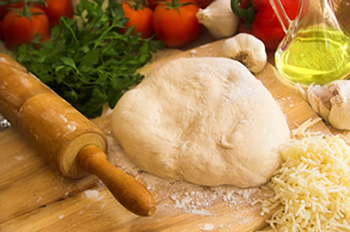Home > How to make Pizza
It’s easy to learn how to make pizza …
It all begins with the dough. If you can make yeast bread, then making pizza crust will be a snap. Making pizza is actually a snap even if you don’t know how to make yeast bread.

[includeme file=”includes/google-336×280-pizza-top.html”]
Where did Pizza originate?
Pizza as we know it today originated in Naples, Italy in 1889. Raffaele Esposito, a baker, created a special dish to honor the visiting king and queen of Italy, Umberto and Margherita. Esposito topped Neapolitan flat bread with green basil, white mozzarella cheese, and red tomato sauce to reflect the colors of the Italian flag. Of course, many bakers soon copied the dish.
People of ancient Middle Eastern and Mediterranean cultures made an early form of pizza by baking bread, with simple toppings, on stones in a wood-fired oven.
Types of Pizza
Pizza can be made in many forms. You can grill it or bake it in a brick oven (or a simulated brick oven), make deep dish pizza or prepare the pizza dough in your bread machine and then bake it in a pan or on a baking stone.
Here are some of the common types of pizzas.
Pizza recipes
Try some of these homemade pizza recipes
- Neapolitan pizza is thin and round.
- Sicilian pizza is rectangular and thick.
- In a Chicago-style pizza, layers of toppings fill a high-edged crust in a deep pan.
- New York style pizza has a thin crust with a thick, puffy outer edge.
- A calzone is folded pizza dough baked with the toppings inside.
Topping the Pizza
Once you learn how to make pizza crust you really like, then it’s time to perfect the toppings. Pizza tastes so much better when you use the freshest ingredients. If you have the time (or inclination) to make your own sauce, we highly recommend it. Not only does it make the pizza taste better, your friends and family will be so impressed.
[includeme file=”includes/google-336×280-pizza-top.html”]
Freezing the Pizza Crust
After you’ve baked the pizza crust, it can easily be frozen and kept for as long as six months. Just be sure it is completely cooled before freezing. Wrap it in plastic first, then in foil. When you want pizza, take the crust from the freezer, cover it with topping, and place it in a preheated 400°F oven for 10 minutes. You don’t even need to thaw the crust.
Resources to help you learn how to make pizza:
Homemade pizza recipes –
This section includes recipes for all types of pizza from breakfast pizza to taco pizza and every pizza in between.
Pizza ingredients – Are you looking for a special ingredient for your pizza? We have some special products to make your pizza taste even better.
Pizza Supplies – We offer a variety of pizza peels, pizza stones, and other pizza pans and tools.
Pizza Cookbooks – We have a wonderful selection of cookbooks such as American Pie: My Search for the Perfect Pizza by Peter Reinhart and Pizza on the Grill: 100 Feisty Fire-Roasted Recipes for Pizza & More by Elizabeth Karmel.
Pizza mixes – If you’re not ready to make pizza completely from scratch but want that homemade taste and experience, then pizza mixes are the next best thing.
Learn how to make pizza in the bread baking blog
Here you’ll find a variety of recipes, including step-by-step instructions on making pizza.
Here are some of the pizzas we’ve featured in the blog:
- Gluten-Free Olive Oil Pizza Dough
- Grilled BBQ Pizza with Whole Wheat Olive Oil Dough
- Grilled Pizza Margherita
- Spelt Pizza
- Southwestern Focaccia/Pizza using Mesquite Dough
Sources:
Reilly, John G. “Pizza.” World Book Online Reference Center. 2008. <http://www.worldbookonline.com/wts/Article?id=ar750160>
Oppenneer, Betsy. The Bread Book. Harper Collins Publishers, Inc. 1994.

Leave a Reply